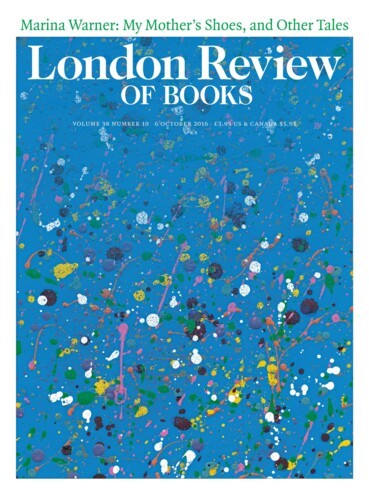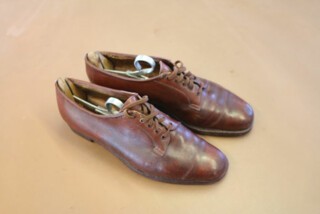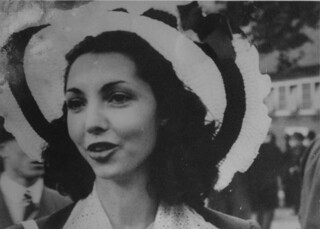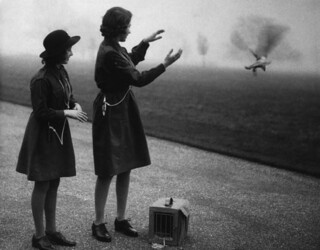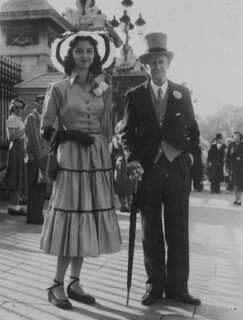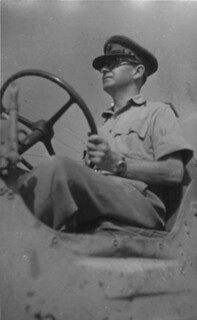When my father, Esmond Warner, known as ‘Plum’ after his father the cricketer, came back at long last from the war, my mother was already in London. She had arrived a few months before from Bari, her home town in southern Italy, flying in on one of the first passenger flights to land in the newly demilitarised airport at Heathrow, and making her own way with her small belongings to her in-laws’ flat in South Kensington, on the first floor of a mansion block between several bomb sites. It was 1945, and supplies were thin: my grandmother lay in her bed to keep warm under her crimpled eiderdown, longing for sweets (and other stimulants). Emilia Terzulli, always known as Ilia, had never left Italy before, and when my father got back, arriving at Southampton from Ceylon (as it then was) on the Queen Mary, which had been requisitioned as a troop-ship, and they were reunited, my 42-year-old father took her – perhaps as a present for her 23rd birthday – to be fitted for a pair of shoes at Peal & Co, a family firm famous for its clientele: Humphrey Bogart! Marlene Dietrich! Fred Astaire! The Duke of Windsor and Mrs Simpson! Each customer was measured, and the findings entered in a series of ledgers known as the ‘Feet Books’; the bespoke shoemakers then modelled wooden lasts to be used to make the shoes; these effigies were labelled with the client’s personal number – my mother’s was 289643 – to be kept in the firm’s store for use when the next pair was ordered. The Peal dynasty of cobblers – which stretched back at least to 1791 or even, some claimed, to 1565, and showed at both the Great Exhibition of 1851 and the Festival of Britain a century later – only stopped making shoes in 1965.
My father never had shoes specially made for him. But he had a strong sense of tribal symbols, developed through a charmed (and anxious) childhood. His father was born in Trinidad, a younger son of the attorney-general; he first played for the West Indies, but then transferred to the England team, which he captained; in 1904 he brought back the Ashes to scenes of huge public rejoicing; and soon after this, he married my grandmother, a gin and port heiress: he was a national hero and the pair were the Posh and Becks of their day; their hundreds of wedding presents were entered in lovely inky copperplate in a leatherbound ledger, numbered in order. Their eldest son would never really be reconciled to the fading of all that glamour.
Plum then went on to manage the England team (his term included the notorious Bodyline tour to Australia in 1932-33). He founded and edited the Cricketer and wrote a score of fluent books on the game (one of his several memoirs is called Long Innings). He didn’t pay much attention to anything other than cricket, and when my father grew up short-sighted and tubby (after his mother), and when a broken big toe effectively ended any career on the field, Plum lost interest in him, inflicting a lifelong hurt that filled my father with an insatiable need for attention and company and diversion and love.
There was no money in cricket, not then, but for my father there was prestige and fun: connections, garden parties and dances. Meanwhile his mother’s fortune was vanishing (gambling, blackmail – stories for another time). He knew he had to find a profession and kept trying his hand at different things: he joined the Coldstream Guards, then studied for the Bar, then took up stockbroking, and worked for a while for Wills cigarettes; in the prewar social whirl, it didn’t seem to matter that he wasn’t settling down. He was enjoying himself, and reading a lot and making friends. In biographies of the period, a group photograph of famous faces will look out at us, and there will be a round cheery figure behind horn-rimmed glasses, and the caption, ‘Unidentified’.
Esmond splashed out on the celebrated Peal’s bespoke brogues for his newly arrived young Italian wife; she was to have the best of English classic design, sturdier by far than a glass slipper, but as clear an expression of his hopes for his bride and his own status. Ilia realised the seriousness of the gift as the Peal family fitter, wearing a grey-beige overall with a tape measure around his neck, kneeled in front of the young beauty this English soldier had brought back with him and drew the outline of her left foot and then her right on the paper he had asked her to stand on. She was 5’10”, very tall for an Italian, and had been nicknamed ‘the giraffe’ at home, where the much smaller local males found her height and thinness and long neck freakish. It took admirers in London, and soon afterwards in Cairo, as well as the fame of Ingrid Bergman, to bring her to realise how much sway she had.
The fitter was cheerful, leaning around her as he chaffed with the lieutenant-colonel about the state of things and the future that lay ahead, when she would be putting on this elegant handcrafted pair of shoes, not the piebald tasselled kind that the Duke of Windsor fancied, but a plain flat lace-up in deep chestnut calf, with ten-point criss-crossed lacing and a short tongue.
How did Esmond pay for the brogues? It wasn’t a question of cash, though he wasn’t particularly flush, because all shoes were an extravagance in the immediate postwar period, when rationing was at its most stringent: a mingy 24 coupons a year were allowed for clothing, compared to 66 during the war itself; the ticket price made no difference, so those with funds could buy far better quality for the same outlay of coupons. A pair of women’s shoes required five coupons – men’s needed seven. This may have been an echo of an old system of pricing shoes: by the size of the foot and the amount of leather. But it may also have given men’s styles more cachet.
The Peal brogue is a woman’s version of a man’s shoe, and the style has made a very strong return, filling the fashion pages and the windows of shoe shops from Bond Street to Shoreditch, favoured by urban professionals, especially young women. But in the 1940s, when Ilia was fitted, they announced her life to come in the English countryside, her formal enrolment in the world of the squirearchy, the hunt-to-hunt, the point-to-point, the open garden scheme, the charity fête. During the war, the princesses Elizabeth and Margaret had worn them to review the Girl Guides and launch messenger pigeons. Ilia knew none of this when her narrow foot was measured – size five and a half, but the left slightly longer than the right – though she understood that she would no longer be stepping out in strappy cork-soled high sandals to swing down the Lungomare in Bari in the blessed cool of a summer evening, arm in arm with her sisters and cousins and their friends on the ritual passeggiata, let alone be squeezing the warm wet sand under her bare feet by the Adriatic near the harbour of the city where she grew up. The brogues would walk her safely on turf and moorland and through woodland and along river banks where the trout twinked to the surface for water boatmen and flies, and take her striding across winter fields where the pheasants whirred up, a flurry of gorgeous feathers against the unrelenting grey; the brogues would plant her on – they would transplant her to – British soil.
According to the OED, the very first meaning of the word brogue, dating to 1575, was ‘an escheat; a cheat, fraud, trick’. Escheat: a common law that allows the Crown to take over property when someone dies intestate. Severed inheritance is implied here. More than two hundred years later, this sense had not yet faded; with a cheeky rhyme, Robert Burns attributed such devices to the devil: ‘Then you, ye auld, snic-drawing dog!/Ye came to Paradise incog/An’ play’d on man a cursed brogue.’ By the time Burns was writing, ‘brogue’ also commonly described ‘a rude kind of shoe generally made of untanned hide’, and worn in the ‘wilder parts’ of Ireland and Scotland. But the dictionary’s earliest example for its meaning footwear (1586) came into use when the word still meant a fraud; the entry suggests it might be related to ‘breeches’, and perhaps recalls the rough leggings worn by Irish peasants and Scottish Highlanders. They could rise to the knee and above, and were often heavy: in Cymbeline, for example, Arviragus wears ‘clouted brogues’.
Dr Johnson shows detailed curiosity about Highland costume; it had been banned after the Jacobite uprising of 1745, but it was, he noted, still occasionally seen in all its splendour. He first saw brogues on Skye: ‘a kind of artless shoes, stitched with thongs so loosely that though they defend the foot from stones, they do not exclude water’. Each man made a pair for himself as a ‘domestick art … as the wife made an apron’, using rawhide with the fur side inwards and dyed with juice of tormentil. That was in 1773; in 1825, another observer commented even more warmly that ‘for real elegance there was nothing to beat the women of St Kilda: their menfolk might wear simple brogues, but they themselves had shoes of gannets’ skins, and were said to look like “feathered Mercuries”.’
Sometimes brogues rose above the knee, like fisherman’s waders: clearly their rusticity defined them, not their shape. These serviceable homemade brogues could translate a labourer into a nymph, a shepherd into a dweller in Arcadia; they were brimming over with the spirit of Romanticism, passion for the elsewheres and the beyonds, for heath and moorland, cliff and crag, cataract and glade, for long drifting walks through the night, as when Dorothy Wordsworth and William and Coleridge set out to watch the moon rise over the Severn.
The association with the country as an authentic native place, defined by appealing local idiosyncrasies, becomes key to the word’s peregrinations. The literary scholar Kathryn Sutherland remembers from her Scottish childhood that, in Gaelic, brogue also means ‘sorrow’ and brog, ‘sorrowful’. She suggests that leave-takings are perhaps cause for sadness, as when someone sets out on a journey, shod for the hardships en route. But she also proposes an association with ‘clog’ – ‘a thick piece of wood; block … Anything that impedes’, and, finally, ‘a wooden-soled shoe’. Shakespeare uses ‘clog’ in this sense many times: in Coriolanus, Volumnia cries out: ‘I would the gods had nothing else to do/But to confirm my curses! …/it would unclog my heart/Of what lies heavy to’t.’ Shakespeare, as ever writing close to and with the body, segues from what trammels the feet, like a clog or a brogue, to speak of what weighs on the spirit or the heart.
Highland brogues were much heavier, tougher workwear than today’s stylish and mannish shoes for women, though some of this newly aroused longing for reconnection with land and place, alongside a strong association with strength and stamina, for vigorous, lithe female bodies capable of striding across such landscapes, may be contributing to the vogue today. The 18th-century Highlands conveyed the wild side to the London tourist. Johnson wrote from Skye, sounding delighted at his daring: ‘I have now the pleasure of going where nobody goes, and seeing what nobody sees.’ Peter Levi’s perception rings true, I think, when he comments: ‘What Johnson specially wanted in Scotland was to understand wild or primitive or savage life … He felt some of the emotions in the Highlands that Darwin in the Beagle felt when he saw his first savage.’
The craze for Scotland that Victoria and Albert spurred on when they began to spend time at Balmoral, trout-fishing and deer-stalking and papering their walls in tartan, changed the definition of upper-class leisure. Brogues began their social ascent once hunting, once necessary for survival, became entertainment. Animals large and small, and every kind of bird and fish to be found the length and breadth of the globe (and the empire), were slaughtered by the hundreds and even thousands, some of them beheaded to be stuffed and mounted, others mummified whole, their mottling and colours and plumes displayed in glass domes or rectangular vitrines, hung in serried phalanxes on the walls of Sandringham and Balmoral, and in hunting lodges and country retreats everywhere, the domestic interiors of these pleasant refuges now becoming vast animal mausoleums, with the large sad eyes of quarry looking down glassily on the company enjoying themselves below, and their towering racks of antlers or marvellous scimitar horns thrusting hopelessly into the air above the jollity.
At some point in the Victorian era, this kind of shoe – and its regional name – migrated south. In the New Yorker recently Christopher Glazek discussed the way hoodies became ‘elite’ and it’s a general vector of fashion that it plunders the slums for its styles, just as it’s a fashion photographer’s cliché to shoot, in graffiti-spattered rust-belt ruins, luxuries that would help repay the debts of a small nation-state. Brogues, imported to the upper echelons, belong in the company of R.S. Surtees’s genial cast: Mr Sponge’s Sporting Tour (1853), lightly illustrated by John Leech, was one of my father’s favourite books, the very mention of it bringing out a rumbling chuckle of pleasure. Brogues also crossed the gender divide and they helped emphasise the newly admired boyish silhouette of the iconic 1920s gel, a tennis player and a golf champion, a huntswoman and a show jumper, Miss Joan Hunter Dunn or an Olympian (‘Oh! Would I were her racket press’d/With hard excitement to her breast/And swished into the sunlit air’). Esmond was an exact contemporary of Betjeman and they shared many pursuits besides – the niceties of snobbery, parish churches, clerihews, droll epitaphs.
Golf and croquet also rose in popularity – for both sexes – from the latter part of Victoria’s reign into the 1920s (which is when Esmond began going out and about with his much more handsome and well-heeled friends). Both sports required sensible and appropriate footwear. In the last panel of his Bilderatlas, Aby Warburg identified a photograph of a female golfer in full swing as the latter-day reincarnation of the striding Nympha of antiquity. Again, it was brogues – admittedly made to slightly different patterns, ornamental trails of punctures traced in the leather and variations in the lacing and the soles – that were worn to saunter on the green and stride the course or walk around the hoops on the croquet lawn. Many games were central to the country house weekends that filled my father’s prewar days with the chums he’d made at school and at Oxford; some of the time was spent playing cards and billiards and chess, but mostly they liked being out of doors. Steeplechasing, fly-fishing, race meets and riding to hounds, beagling, even otter-hunting and drinking (flasks of cherry brandy against the cold) kept them busy. He’d play a round of golf now and then when he was still an undergraduate and go to the races whenever he could. The Dublin Horse Show was a fixture in the social calendar of his tribe, along with parties in the houses of the Anglo-Irish, which were still flourishing in spite of the new Republic and the burnings. It is one of my sharpest memories that when I was quite young he showed me the group photographs of the Bullingdon Club and pointed out each of his friends: ‘Tore out his tubes in a fit of DTs,’ he’d say of one; ‘shot his brains out,’ of another. It was the difficulty at the core of his whole being that he’d hung around with this crowd when he didn’t belong, and hadn’t the money for it either. Later, during the war itself, any chance he got for furlough, he’d go to Cairo because, at Gezira Sporting Club on the island of Zamalek in the middle of the Nile, there was a splendid golf course and racetrack. During the North Africa campaign he wrote to his mother: ‘Cairo is my second home.’ It was there, after the war, that he finally found his métier – as a bookseller.
Not many of these leisure pursuits were known to Ilia growing up in Bari, an old town surrounded by the most ancient and magnificent olive groves in Europe. Men with hunting rifles ranged the country as the songbirds winged their way south, dovecotes were as common as sheepfolds, and in Rome and Naples unofficial races were held, sometimes in trotting calèches. But the golf course, in a terrain where there were no great rivers like the Nile and scant rainfall, was as yet unknown. And besides, unmarried girls of the town did not hunt or shoot. When Ilia was given a pair of brogues made to her unique measurements, she understood their elegance and the craft that went into making them, but they were never really her kind of shoe. She kept them carefully in their original trees, and when she died they were in her wardrobe. They show small signs of wear, but they had been treasured for another reason: they marked a rite of passage, a kind of initiation into a caste, into a tribe, into a new place of belonging, just as Cinderella’s foot uniquely matched the glass slipper which would transform her fate.
A brogue establishes connection with a certain stretch of ground or site, but as an article of dress that covers up the naked foot, it belongs to a costume or a livery, part of a chosen role – or an assigned one. Those bespoke brogues were my father’s way of saying that Ilia Terzulli was now an Englishwoman. (A childhood friend recently reminded me that when he brought her into the mess, an officer shouted: ‘What’s that bint doing in here?’ To which my father replied: ‘I’ll have you know, sir, this bint is Mrs Warner.’)
The OED and other dictionaries aren’t sure that the second meaning of ‘brogue’, which refers to a kind of country accent and intonation and idiom, has any verifiable connection with its meaning a certain kind of shoe. Although they insist its derivation is unknown, the Oxford lexicographers concede that the link may have arisen because the same people who wore brogues – the Irish and the Scots – spoke that way when they spoke English. Rustic garments, rustic speech. Yet the usage arrives later – the first instance given is 1705. One etymological dictionary surmises: ‘Or perhaps it is from Old Irish barrog, “a hold” (on the tongue).’ It resonates with ‘broad’ and ‘broken’, too, though these are just coincidences. But the inference must be that a brogue clogs the tongue of folk who are also trammelled by heavy soil and heavy footwear, and that such speech is a sorrow – to them (it marks out the unfortunate and the oppressed), and even, perhaps, to us, on the receiving end of this rough language. Might the concept of fraud, linked to loss and rupture as in ‘escheat’, also be buried deep in this transmission, the word ‘brogue’ carrying the suggestion that people who speak this way aren’t going to inherit the earth? Or that their speech travesties the original?
Not all the quotations supplied by the dictionary are pejorative, and brogue is often charming, lilting and seductive. As a term, it hasn’t wandered far from Ireland or Scotland, and it means a native tongue in the crucial sense that a language is a particular kind of music, not only a sign system on the page or a structure of grammar. It is also a tune, a pattern of sounds and intonation. A brogue isn’t a foreign accent, not exactly: it can be a way of speaking your own tongue. Colm Tóibín recently recalled that when his grandfather was arrested for his part in the Easter Rising, he was sent to prison in Wales, and found to his surprise – his dismay? – that the guards were all Welsh speakers, while the Irish prisoners all spoke English.
It seems very odd to me that this most resonant word, ‘brogue’, hasn’t been extended to other languages besides English as spoken by Irish and Scots. English, now used all over the world in different sectors (world literature, as well as finance, air traffic control, diplomacy), comes in various acoustic forms, peculiar to certain regions, but again it isn’t only a question of accent or of borrowings and creolisations as in Chinglish and Globish, because many of these Englishes may be the speaker’s only language.
The current growth of multilingual communities, nested inside societies of migratory labour such as the Gulf States, the United States and many of Europe’s great cities, has made brogue a very common feature of the contemporary sound landscape: North Africans and West Africans and Middle Easterners speaking French are often fluent – indeed it may be their first language – but their voices have a particular tune. An accent is different in one salient way: it usually signifies a second language acquired later in life, a way of pronouncing certain consonants and inflecting the words that differs from that of a native speaker. Distinctions between creole, patois, dialect and brogue are a matter for linguists, but when I hear the voices of Trinidadians in London or Lebanese or Malinese in Paris speaking English and French, it’s not the unknown phrase or the vocabulary or syntax that helps me recognise them, but the way their speech sounds. A brogue is also typical of bilingual or trilingual experience. Yet the very concept of a brogue arises from old maps that demarcate peripheries from metropoles, and it assumes that the metropoles determine the way Standard English or French is spoken.
Seamus Heaney, whose own voice had a marvellous music that became famous through the resonant recordings he made, thought about this throughout his work of criticism, and especially in an essay in Finders Keepers, in which he explores a phrase from his native Ulster: ‘Through-Other’, a tongue twister which means as it sounds, ‘things mixed up among themselves’, ‘physically untidy or mentally confused’. Heaney rejects any tinge of criticism, however, adopting the messiness of through-otherness as a modus operandi. He himself had struggled throughout the Troubles to keep faith with his multiple inheritances – Catholic, Irish, Ulster, English, farming, scholarship, manual labour, literature, masculinity, femininity – and at the level of language itself he registered their dissonance as honestly as he could, keeping the hum of the Irish in his ear as he was writing in English, and sounding the Anglo-Saxon of Beowulf and the Scots of Robert Henryson in his translations/revisionings. He saw the fractures and mix-up of his own inheritance and career – born Irish, writing in English, and a long-time resident in America – and chose, with his characteristic search for redress, to make the best of it.
So he underscores here the work of language as a pattern of sounds rather than a communication of sense, argument or idea; he stresses the parts of speech that belong with birdsong, animal cries and whimpers, chimpanzee chest-thumping:
It is not only a poem’s explicit political concerns and paraphrasable content that need attending to. A précis of the content, for example, takes no account of the literary echoes and allusions which can be fundamental to its poetic energy. In a poem, words, phrases, cadences and images are linked in to systems of affect and significations which elude the précis maker. These under-ear activities, as they might be termed, may well constitute the most important business which the poem is up to and are more a matter of the erotics of language than the politics and polemics of the moment.
Under-ear activities … how can this relate to shoes as well as voice?
What could be the connection between brogue on the foot and sounds in the ear and on the tongue? Oddly, shoes have a tongue, as if cobblers imagined they could speak. In his marvellous silent routines Charlie Chaplin, the tramp down on his uppers, dances the bread rolls like shoes and eats his boot, twirling the laces like spaghetti; Jan Švankmajer, the Czech surrealist and filmmaker, has animated shoes as wide-open cannibal mouths. I’d claim there’s a deeper affinity between the way you’re shod and the way you talk and who you are: that a brogue is an under-ear mark of identity, a sign of tribal belonging and origin; it is the way you say the words in the country of words that you come from. It could be synonymous with ‘mother tongue’ except that it doesn’t assume that affiliation runs through blood or the female line; it substitutes a sense of Romantic wilderness – earth, bog, fen, marsh, scarp, turf – for the symbol of the motherland. Its homophonous link to the rude shoe for the wilder parts of Ireland and Scotland nudges its meaning towards place, not kin: the way you speak tells where you come from, which might cohere with your folks, your family, including but not only your mother. You can be an orphan alone in the world but your brogue keeps the memory trace of the place where you first learned to speak. You can be at home in a brogue, you can live in it – a sleek and comfortable pair of slippers, even if not made of feathered gannet skins. A brogue evokes lilt and cadence and pitch and the melodic undulations of speech. Your brogue gives you new bearings, and helps others recognise you. It’s always possible to be fluent in the semantics and syntax of a language, but very rarely can you lose that trace and texture and intonation of your own language: this remains, your unmistakable brogue, and you can claim rather than forfeit your inheritance through its music.
This deep trace of origin has played a part in horrors of ethnic cleansing, and during the current wave of xenophobia, it’s worth remembering this history in order to change the way we respond to arrivants’ ways of saying things. The Bible tells a very nasty story of how friend was sifted from foe in the battle between the Gileadites and the Ephraimites. Everyone wanted to cross the river to safety but the Gileadites were guarding it, and they were asking not for a password as such, but for the petitioner to pronounce the word ‘shibboleth’. Ephraimites didn’t have a ‘sh’ sound, so if someone wanting to cross the bridge said ‘sibboleth’, he was an Ephraimite, and put to death – according to the Book of Judges, 42,000 of them were slaughtered. This horrible origin of the term ‘shibboleth’, meaning a tribal belief that defines one group against another, has many gloomy counterparts in the history of civil conflicts and feuds. The poet and artist Caroline Bergvall remembers in Say Parsley, a sound work performed in 2001, that as recently as 1937, in the Dominican Republic, ‘parsley’, perejil, became the brutal test: if you couldn’t pronounce the ‘r’ Spanish style, you were murdered.
While these marks of identity have been used to divide people and kill them, they could instead be a way of rethinking your bearings, of not losing altogether the places of your past even when you’ve been dislocated. The way you hold onto the sounds of your other, home language in the new one you need to acquire if you’re to make your way in the new place is connected to the way the huge migrations of recent years are reshaping the nation-state; like a tune, like a blow-in species of flower, like a story, speech patterns are no respecters of borders.
In his famous meditative poem ‘An Ordinary Evening in New Haven’, Wallace Stevens calls to mind
The spirit’s speeches, the indefinite,
Confused illuminations and sonorities,
So much ourselves, we cannot tell apart
The idea and the bearer-being of the idea.
He means here, with Heaney, that sound and sense are enmeshed, and that babel or medley are important, not to be consigned to condescending criticism or inattention, because such confused illuminations and sonorities are the necessary vehicle: they bear ideas and circulate them among us over millennia to keep us involved with one another – emotionally, ethically, historically. My mother wasn’t forced to become an Englishwoman, she chose it by marrying my father, but it beckoned for reasons that reflect the mass movements of so many people today.
In The Tempest, Caliban cries out in rage and anguish against Prospero’s treatment of him:
You taught me language and my profit on’t
Is I know how to curse: the red plague rid you
For learning me your language!
His bitter sense of betrayal epitomises the cost of assimilation, concedes that the process will never be complete (strangeness and not belonging will out) and that rejection hurts even more when an effort to overcome difference has been made.
It’s worth noting at this point that missionaries taught natives to wear shoes.
And yet, even while Prospero is clearly the tyrant coloniser, Caliban is given some of the richest imagery and most eloquently expressed emotions in a play that is distinguished by its poetic language, its singular lexicon, and its modulated range of feelings, from comic to lyric to tragic. He is also highly articulate when he curses. Caliban inhabits fully the language he has been taught, and takes it further. The island is his island of words, where he is alone in not being afeared of the noises, sounds and sweet airs, and in understanding what they say; only he knows where the scammels in the rocks are, and indeed what scammels are (this is one of many hapax legomena in Shakespeare). Caliban doesn’t lose his identity because he speaks in English, nor does it make him inauthentic or homeless. He too is dwelling in a language and its words, putting on its brogue.
My mother put on her brogues that first year of her marriage when she was at the beginning of the process of acquiring English. But is it possible to learn a brogue the way you can be fitted for tribal footwear? She became completely fluent in the language of her new place of belonging – the language of her daughters – and she soon began to write and think and even dream in English, Italian returning as the default only when she played cards, cast off stitches and prayed. She didn’t have much of an accent, but the tune pattern of her speech and the dance of her gestures were always identifiably Italian and southern Italian at that.
The brogues were my mother’s proof of membership, a swipe card, a badge which gained her entrance to a certain way of life – a certain caste, if you like. Like a way of saying things, they located her. They fitted snugly, and gave her grounding in her new home; they expressed her English husband’s designs on her and her acceptance at this stage of the freedom she had achieved from the Fascist-stricken, war-torn Italy that had been her whole life until she left. Yet for me the sight of her crafted brogues from Peal & Co is soaked with the sorrow of the accommodation she made; the shoes were a kind of trick, a disguise.
The end of the war found Esmond jobless, alongside thousands of others, and he lit on the notion that all would be well if he returned to Cairo, his second home. He had friends on the board of W.H. Smith and persuaded them that there was a wide-open market in the English and French-speaking communities, and that they could trade educational books into the Levant and into Africa; amazingly, they agreed, and in 1947 he opened Smith’s Cairo House. His telegraphic address shows his pride: Bookman, Cairo.
There was a retail shop called Isis on Zamalek island and a warehouse on Sikket el Fadl in downtown Cairo, the modern part of town, where he went to his office every day. He dealt in everything from newspapers to antiquarian treasures, in French as well as in English, but his letters show that the social round still dominated his interests. He was hoping, in urbane, nostalgic, luxurious (rations-free) colonial society, to regain the lost time, the milieu he’d so enjoyed in his youth in a city where it was still flickering undimmed, in the protectorates of imperial confidence. At the cocktail parties and the dances, on the golf course, at the yachting club, and round the swimming pool at Gezira, he could re-create the joy of those wartime furloughs. Besides, the climate was close to southern Italy’s, and the winter of 1946-47 had been the coldest on record. I think my father worried that Ilia would wither away if they stayed in England any longer. In Cairo, in the flat in Soliman House with views of the Nile from the front and of Gezira at the back, she thrived.
Sikket el Fadl was very near Edward Said’s father’s Standard Stationery Company. Both premises were targeted – as foreign-owned – in the uprisings of 26 January 1952. I remember going to the building on Sikket el Fadl with its turban turrets – it is one of my earliest memories, and I was proud and happy that my father was taking me with him on my own – to see the damage. There were ashy tombstones that had been books, the concrete stairs were charred and, sitting on top of the pile of scarred rubble, the porcelain bowl of the lavatory – Shanks & Co, Glasgow.
In Cairo many people spoke in different tongues, and Ilia was among them. Her Italian receded, though later she began teaching it for A-level: when she went back to Italy for holidays, younger people congratulated her on her perfect command of the language – theirs had moved on. Maybe her delivery had become old-fashioned, the Italian equivalent of Celia Johnson’s English in Brief Encounter. But her under-ear speech – her brogue – always reverberated to the notes of the native place she had left behind, as she reviewed and recalled her story and made up new ways of telling it.
Send Letters To:
The Editor
London Review of Books,
28 Little Russell Street
London, WC1A 2HN
letters@lrb.co.uk
Please include name, address, and a telephone number.
